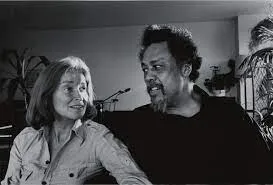Thomas Reichman made this fascinating cinema vérité documentary on Charles Mingus in 1966. It was filmed during a particularly unsettled period in Mingus’s life and documents his eviction from the Lower East Side loft at 22 Great Jones Street where he had intended to open a music school, one conceived of as an extension of the Jazz Workshop concept he’d established with his ensembles years earlier. His six-year-old daughter Carolyn Keki Mingus is seen thoughout the film, and her memory of living on Fifth Avenue underscores the financial and emotional decline Mingus was in when the New York police and sanitation workers arrived on November 22, 1966 to remove his belongings, including his bass, from the premises.
But what became of the shotgun? Both the gun and a box of hypodermic needles which he used for Vitamin B injections were confiscated, but the following day when he arrived at a local precinct house with permits for both, he quipped, “It isn’t every day you see a Negro walk out of a police station with a box of hypodermic needles and a shotgun.” But Mingus’s humor hardly masked the chaos and confusion that reigned over his life. In his biography of the great composer and bassist, Myself When I Am Real, Gene Santoro writes, “Mingus was unable to shape all the minidramas and narrative themes he’d woven as his existence…For the next three years,” he suffered “a series of breakdowns that punctuated his life and undermined his will to create music.”
Along with the Les Blank documentary on Lightnin’ Hopkins that I wrote about two weeks ago, this was a film that I saw several times in the early 70’s, the same period in which I began seeing Mingus in concert after his celebrated return to the scene; later in the decade I presented the film in a series of Black History Month events at Prospect House in Worcester. One of these was attended by a man who’d been a roommate of Tom Reichman when he was making the film. He came with the sad news that Reichman, who’d worked for CBS-TV in New York, had succumbed to depression and committed suicide a few years earlier. He felt that the filmmaker, who also functions as an off-camera interlocutor, identified with Mingus not only as an artist at the economic margins of society, but as a man beset with emotional anguish. The volatile, self-contradicting, gargantuan Mingus is very much in evidence in Reichman’s film.
At the 20:00 mark, Mingus attends an anti-war demonstration and is heard reciting Martin Niemoller’s “First They Came,” a poem about the silence of those who witnessed the successive waves of Jews, Catholics, unionists, and others, ultimately themselves, who were targeted by the Nazis. Mingus adapted the poem for his composition “Don’t Let It Happen Here.” His fourth wife, Sue Graham Ungaro Mingus, who later founded the ensembles Mingus Dynasty and the Mingus Big Band and wrote of life with Mingus in her memoir Tonight at Noon: A Love Story, is seen walking with him at the rally, and in the photo below. At 39:13, Mingus’s poem “Freedom” is heard on the soundtrack as he and Sue walk along 125th Street.

The film includes scenes of Mingus playing “All the Things You Are,” “Secret Love,” “Peggy’s Blue Skylight,” and “Portrait” at Lennie’s-on-the-Turnpike in Peabody, Mass., as well as footage of Mingus’s 1962 Town Hall Concert. The band at Lennie’s includes Lonnie Hillyer, trumpet; Charles McPherson, alto sax; John Gilmore, tenor sax; Walter Bishop. Jr., piano; and Dannie Richmond, drums.
Today is Charles Mingus’s 91st birthday anniversary. You can read more of what I wrote about him a year ago, and several interesting reader comments, here. In tonight’s Jazz a la Mode, we’ll hear four titles from Mingus’s 1957 masterpiece, Tijuana Moods, and a set of his compositions featuring the tenor saxophonist Booker Ervin. In his 1982 publication, Mingus: A Critical Biography, Brian Priestley writes that Ervin’s “scorching tone and polytonal improvisation[s] added an intensity to Mingus’s music hitherto only occasionally matched by Jackie McLean or Jimmy Knepper. Finding such a soloist may have helped to convince Mingus that it was after all possible to express yourself without resorting to violence…”